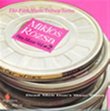| All Artists: Xie Xuemei Title: Xie Xuemei Members Wishing: 1 Total Copies: 0 Label: Str Digital Original Release Date: 6/1/2002 Release Date: 6/1/2002 Genres: Dance & Electronic, International Music, Pop Style: World Dance Number of Discs: 1 SwapaCD Credits: 1 UPC: 797127100620 |
Search - Xie Xuemei :: Xie Xuemei
 | Xie Xuemei Xie Xuemei Genres: Dance & Electronic, International Music, Pop
The Zheng is a traditional Chinese string instrument similar to a zither. It was popular in the Qin Dynasty (221BC-206BC) about two thousand years ago, when it was known as the ÔQinzhengÕ. With its long history a... more » |
CD Details
Synopsis
Album Description
The Zheng is a traditional Chinese string instrument similar to a zither. It was popular in the Qin Dynasty (221BC-206BC) about two thousand years ago, when it was known as the ÔQinzhengÕ. With its long history and large variety of elegant and uncomplicated compositions, the instrument has deeply impressed people. In time the instrument became known as the 'Guzheng', 'gu' meaning ancient and illustrating the refinement of the instrument. The Guzheng was traditionally played with the right hand plucking strings on one side of the string post and the left hand pressing the strings on the other side of the string post. However, some of the traditional right-hand techniques have been borrowed by the left hand so the instrument can now be played in the traditional way or in a more modern way. The left hand enhances the tone of the instrument and also cooperates with the right hand, plucking strings to produce polyphony and other more difficult musical effects which cannot be achieved with the traditional method of playing. With this development, the breadth of expression of the instrument has been greatly enhanced, opening up a whole new direction for composition. The continual development in performance techniques has altered make up of the Guzheng. A type of Guzheng with five strings existed during the Qin Dynasty. The number of strings was increased to 13 during the Sui (AD518-AD618) and Tang (AD 618-AD 907) Dynasties. Fourteen and 16-string instruments were developed during the Yu, Ming and Qing Dynasties (AD1616-AD1912). From 1930 to the present, the number of strings has increased to 18, then to 21, 23 and finally 25, greatly expanding the capacity of the instrument. Along with the changes in the Guzheng's construction, industrial developments have brought about changes in the materials used for making the strings. In ancient times silk was the most widely used material. Copper wire became the main material during the middle years of the Qing Dynasty (AD1644-AD1911). From the last years of the Qing Dynasty until 1960, strings made of copper wire wrapped in silk were used extensively. In the mid 1960s strings made of steel-wire wrapped in nylon replaced other kinds of string, becoming the type of string generally used by Guzheng experts. It is believed this type of string improves the tone of the instrument. The instrument is becoming more popular and played in more regions than ever before, being well integrated with local operas, story telling and music based on local dialects and customs. The development of various schools, each with its own style and performing techniques, has also helped to promote the instrument and to encourage further development of performance techniques. As a result, the Guzheng has influenced professional music education in China as Guzheng departments have been established in most music schools throughout the country. The instrument has strong artistic expression, due mainly to its flexible structure and the comparative freedom and elasticity of each phoneme. The main part of the instrument is its resonator. The quality of the instrument depends on the selection of vibrating board and the arrangement of the sound beam inside the resonator.
Similar CDs
| Miklos Rozsa, Lee Holdridge Dead Men Don't Wear Plaid Genres: Pop, Soundtracks Label: Prometheus | |
| Various Artists Patriotic Super Hits Genres: Country, Special Interest, Pop Label: Sony | |

 Track Listings (9) - Disc #1
Track Listings (9) - Disc #1


